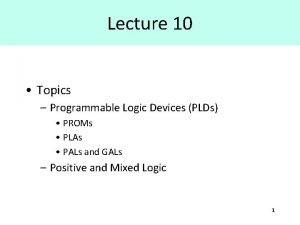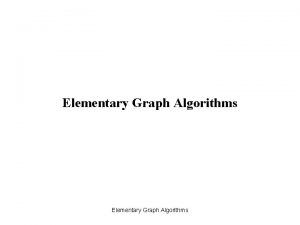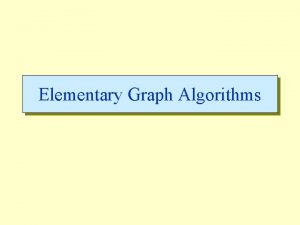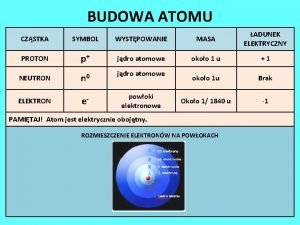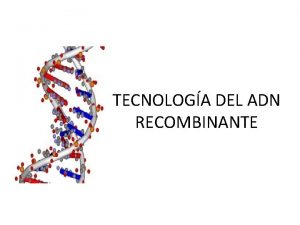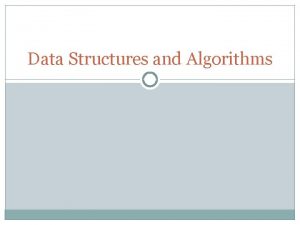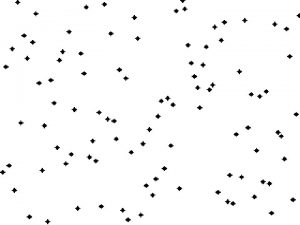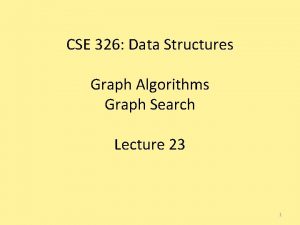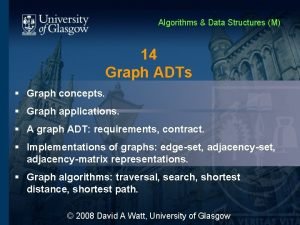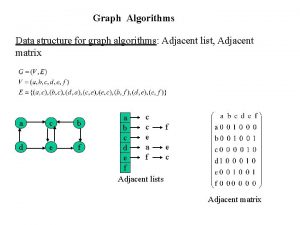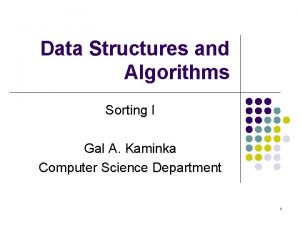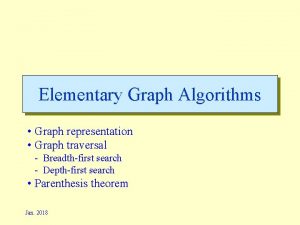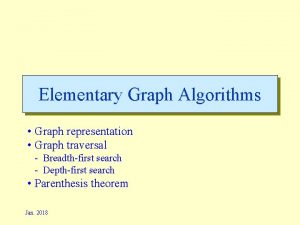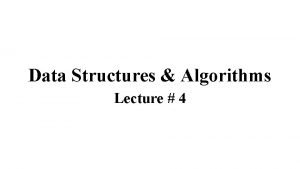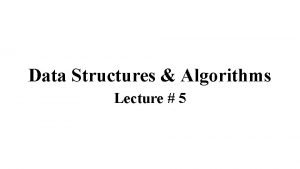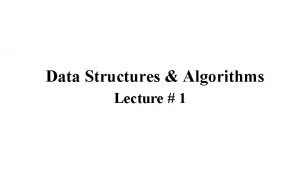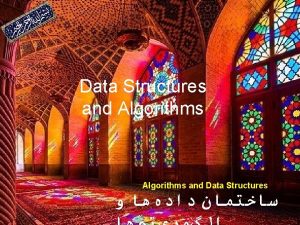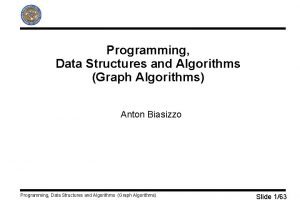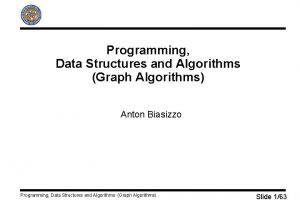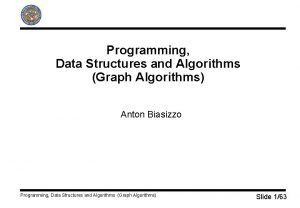Data Structures and Algorithms Graph Algorithms II Gal



















![pathk[i][j] = 1 vi vj Case 1: l There is a path from i pathk[i][j] = 1 vi vj Case 1: l There is a path from i](https://slidetodoc.com/presentation_image_h/1e237972d0155f1c32848d177e1d1391/image-20.jpg)
![pathk[i][j] = 1 vi vk vj Case 2: l There is a path from pathk[i][j] = 1 vi vk vj Case 2: l There is a path from](https://slidetodoc.com/presentation_image_h/1e237972d0155f1c32848d177e1d1391/image-21.jpg)



- Slides: 24

Data Structures and Algorithms Graph Algorithms II Gal A. Kaminka Computer Science Department 1

Representing a relation l l l Given a set S Given a mathematical relation R on S x S We can represent R as a directed graph as follows l l l Gr = < V, E > V=S E = { <e 1, e 2> | e 1, e 2 in S, (e 1, e 2) in R } 2

Partial and total orders l l R can represent a partial order, or total order Partial order: l l <a, b>, <c, b>, and unknown <a, c> nor <c, a> In graph: <a, b>, <c, b> and not <a, c>, <c, a> Sometimes called precedence relationship Total order: l <a, b> <c, b> implies either <a, c> or <c, a> exists 3

Problem 1: Determining a Linearization of R l l Let R be a relation with a partial order For example, order of dressing in the morning Socks Underwear Pants Belt Shirt Tie Shoes Watch Jacket 4

A Topological Sort l A linearization of R: l l An ordering of the vertices such that— If <u, v> is an edge, then u precedes v This is called a topological sort of R R may have multiple correct sorts 5

Topological Sorting l l Begin with DFS, and an empty list Extend it such that: l l It works on unconnected graph Whenever it backtracks Put the current node in front of a list -- O(1) At end, list has vertices in a correct order l Topological order (linearization) 6

Top-Sort(graph g) 1. 2. 3. 4. 5. l new list Unmark all vertices in g for each vertex s if s unmarked, Modified_DFS(G, s, l) return l Modified_DFS(graph g, vertex s, list l) 1. 2. 3. 4. 5. mark s for each edge <s, v> if v is not marked Modified_DFS(G, v, l) insert_in_front(l, s) 7

Example 2 Underwear Pants 3 Socks 2 2 Shirt 4 2 Belt 2 Tie 4 Shoes 1 Watch Jacket Shirt Tie Socks Underwear Pants Shoes Belt Jacket Watch 8

Problem 2: All reachable vertices l l Suppose we are given a graph G, and a vertex v We want: What vertices reachable from v? Reachable(G, v) 1. l new list 2. Unmark all vertices in G 3. Modified_DFS(G, v, l) 4. return l 9

Problem 3: Computing transitive closure The transitive closure of G: l A graph G* is the transitive closure of G iff l For any two edges <a, b>, <b, c> there exists <a, c> l i. e. , <a, b> in G*, if path exists from a to b in G. How can we find the transitive closure of G? 10

Method 1: Matrix-multiplication l l Suppose we are given graph in matrix form A We can use matrix multiplication l l l All paths of length 2 can now be computed as: l l Redefine inner-product (dot-product) of vectors Normally [a b c]. [x y z] = ax + by + cz We redefine: = max [min(a, x); min(b, y); min(c, z)] This is the boolean product A x AT Paths of length d: Ad = A x …. A (d times) 11

Matrix multiplication method l l Paths of length d: Ad = A x …. A (d times) To determine if a path exists of length d at most: l l l Check A 2 Check A 3 …. Check Ad We can calculate the path matrix of order d l l All paths of length d or less pathd = A || A 2 || A 3 || … || Ad 12

Calculating the closure l l The transitive closure as path matrix (of order n) Pathn = matrix of paths of at most length n Closure(graph_matrix A) 1. For k=1 to n 2. For i=1 to n 3. For j=1 to n 4. p path_n[i][] * A[][j] 5. path_n[i][j]= p || path_n[i][j] 6. return path_n 13

Calculating the closure l l The transitive closure as path matrix (of order n) Pathn = matrix of paths of at most length n Closure(graph_matrix A) 1. For k=1 to n Boolean dot product 2. For i=1 to n 3. For j=1 to n 4. p pathn[i][] * A[][j] 5. pathn[i][j]= p || pathn[i][j] 6. return pathn 14

Calculating the closure l l The transitive closure as path matrix (of order n) Pathn = matrix of paths of at most length n Closure(graph_matrix A) ith row 1. For k=1 to n th column j 2. For i=1 to n 3. For j=1 to n 4. p pathn[i][] * A[][j] 5. pathn[i][j]= p || pathn[i][j] 6. return pathn 15

Complexity of this method l Three nested loops, each 1 to n N 3 But inside innermost loop, dot-product N So, overall, O(N 4) l While O(N 4) is still tractable, it is not very good l l 16

Method 2: Improving naïve method l Observation: l l Idea: Use largest intermediate steps on itself l l We are calculating A, Ax. Ax. A, … , An But really, we don’t care about intermediary steps We want An as quickly as possible. Calculate path 2 = path x path Then path 4 = path 2 x path 2, path 8 = path 4 x path 4, . . So then only O(log n) multiplications Complexity improved to O(n 3 log n) 17

Method 3: Floyd-Warshall’s Algorithm Observation: l Suppose we restrict ourselves to first k vertices l l Define pathk[i][j] = 1 iff l l v 0, v 1, …. , vk There is a path from i to j that only uses first k vertices as intermediary vertices But, if there is a such a path p between i and j Then either: l l There is a path that uses only first k-1 vertices from i to j There is a path that uses only first k-1 vertices from i to 18 k from k to j

Floyd-Warshall’s Algorithm vi vj Case 0: l There is no path from i to j using only vertices from the set { v 0, …. , vk } l If so, then pathk[i][j] = 0 19
![pathkij 1 vi vj Case 1 l There is a path from i pathk[i][j] = 1 vi vj Case 1: l There is a path from i](https://slidetodoc.com/presentation_image_h/1e237972d0155f1c32848d177e1d1391/image-20.jpg)
pathk[i][j] = 1 vi vj Case 1: l There is a path from i to j using only vertices from the set { v 0, …. , vk-1 } l If so, then pathk-1[i][j] = 1 20
![pathkij 1 vi vk vj Case 2 l There is a path from pathk[i][j] = 1 vi vk vj Case 2: l There is a path from](https://slidetodoc.com/presentation_image_h/1e237972d0155f1c32848d177e1d1391/image-21.jpg)
pathk[i][j] = 1 vi vk vj Case 2: l There is a path from i to j which uses vertex vk, and vertices from the set { v 0, …. , vk-1 } l If so, then pathk-1[i][k] = 1 AND pathk-1[k][j] = 1 21

In other words…. l l Remember the transitive closure is matrix pathn We can now recursively define pathn: 22

Warshall(graph_matrix G) 1. 2. 3. 4. 5. 6. 7. 8. n |V|, for i 1 to n for j 1 to n if i=j OR <vi, vj> in E then path 0[i][j] 1, else 0 for k 1 to n for i 1 to n for j 1 to n 9. 10. return pathn 23

Floyd-Warshall’s Algorithm Notes l l l Run-time Complexity: O(n 3) Can be modified to compute shortest paths between any two vertices Note that we use only 1/0 markings l Can again use bits to save space (constant factor) 24
 Data structures and algorithms iit bombay
Data structures and algorithms iit bombay Cos 423 princeton
Cos 423 princeton Data structures and algorithms tutorial
Data structures and algorithms tutorial Information retrieval data structures and algorithms
Information retrieval data structures and algorithms Data structures and algorithms bits pilani
Data structures and algorithms bits pilani Ajit diwan
Ajit diwan Data structures and algorithms
Data structures and algorithms Data structures and algorithms
Data structures and algorithms Waterloo data structures and algorithms
Waterloo data structures and algorithms Signature file structure in information retrieval system
Signature file structure in information retrieval system Data structures and algorithms
Data structures and algorithms Algorithms + data structures = programs
Algorithms + data structures = programs Homologous
Homologous Networks and graphs: circuits, paths, and graph structures
Networks and graphs: circuits, paths, and graph structures Advantages of plds
Advantages of plds White path theorem
White path theorem When graphs are life
When graphs are life Elementary graph algorithms
Elementary graph algorithms Undirected graph algorithms
Undirected graph algorithms The game gal
The game gal Gal 5:22-25
Gal 5:22-25 Zevsov oltar u pergamu
Zevsov oltar u pergamu Budowa atomu
Budowa atomu La tecnologa
La tecnologa Gal 5:22-23 niv
Gal 5:22-23 niv














